
In the modern travel landscape, navigating visa requirements can be a daunting task. However, with the advent of technology, applying for a visa has become more streamlined, especially when it comes to destinations like Vietnam. This Step-by-Step Guide to Applying for a Vietnam eVisa aims to demystify the process and provide you with all the necessary information to embark on your journey without a hitch.
Understanding the Vietnam eVisa

As international travel continues to grow, countries around the world are adapting their entry processes to facilitate easier access for travelers. The Vietnam eVisa is one such innovation that caters to the needs of globetrotters seeking to explore the beauty and culture of Vietnam.
What is an eVisa?
An eVisa, or electronic visa, is a digital authorization that allows travelers to enter a foreign country for specific purposes, such as tourism, business, or medical visits. Unlike traditional visas that require you to visit an embassy or consulate in person, eVisas can be easily obtained online. This eliminates many of the challenges associated with traditional visa applications, such as lengthy waiting times and inconvenient paperwork.
The Vietnam eVisa specifically permits multiple entries over a validity period of 90 days. This flexibility makes it an attractive option for tourists looking to explore not only Vietnam but potentially neighboring countries during their stay.
Eligibility Criteria for the Vietnam eVisa
One of the most appealing aspects of the Vietnam eVisa is its broad eligibility criteria. As of August 15, 2023, citizens from all countries and territories can apply for this visa. This inclusivity highlights Vietnam’s welcoming stance towards international visitors, promoting tourism as a key component of its economy.
However, it is crucial to note that while almost everyone can apply, meeting specific application requirements is essential. This includes having a valid passport with at least six months remaining validity upon arrival, alongside providing a passport-sized photo and other pertinent details in the application form.
Benefits of Using an eVisa
The advantages of utilizing an eVisa extend far beyond the convenience of application.
Firstly, the process is significantly faster than traditional methods, typically allowing applicants to receive their eVisa within 3-5 working days.
Secondly, the ability to apply online means that travelers can complete their applications from the comfort of their homes, eliminating the need for appointments and lengthy waits at embassies. This level of accessibility encourages spontaneous travel plans and opens opportunities for last-minute trips.
Furthermore, the eVisa provides a sense of security. With the option to keep a digital copy on your phone alongside a printed version, travelers have easy access to their visa status at all times, reducing stress during travel planning.
Preparing for Your eVisa Application

Before diving into the application process, it’s important to prepare adequately. Ensuring that you have all necessary documents and information ready will streamline the entire experience.
Required Documents for Application
To successfully apply for the Vietnam eVisa, certain documents must be gathered beforehand. The primary document required is a passport that remains valid for at least six months after your intended date of arrival in Vietnam. Additionally, your passport should contain two blank pages for any potential stamps or further documentation.
Moreover, you’ll need a recent, passport-sized photograph in digital format that adheres to specific guidelines. Lastly, a digital copy of your passport’s information page is essential, highlighting the importance of having these documents organized and readily available before starting your application.
Photograph Specifications
Understanding the photo specifications is vital to avoid delays in your application. The photograph must be in color, measuring 4×6 cm (or 2×2 inches) when printed on bond paper.
A plain background is essential, and the photo should capture a full face view without any headgear unless it’s for religious reasons. It can’t include smiling; a neutral expression is required to comply with standards for official documentation.
This attention to detail may seem minor, but failing to meet these specifications could result in processing delays or outright rejection of your application, necessitating resubmission.
Validity of Your Passport
Apart from the other requirements, ensuring that your passport is valid for at least six months post-arrival is paramount. This stipulation remains a common requirement across many countries, reflecting a general concern for traveler security and proper identification during foreign travels.
If your passport is nearing expiration, consider renewing it prior to initiating your eVisa application. Not only will this avoid complications during your trip, but it also provides peace of mind knowing that your travel documentation is in order.
The Application Process

Once you’ve gathered all required documents and confirmed they’re in compliance with specifications, you’re ready to navigate the application process.
Accessing the Official eVisa Website
The first step in your application journey is to locate the official Vietnamese eVisa website. It’s crucial to ensure you’re using the correct site to avoid scams or unauthorized fees. Always look for government-affiliated sites that provide clear information about the application process.
A simple online search can help you find the official portal where you’ll initiate your eVisa application. Bookmarking this page can also save time for future reference, ensuring you don’t miss any updates regarding the eVisa requirements.
Filling Out the Application Form
Once you’re on the official website, the next step is filling out the online application form. This process involves entering essential data such as personal information, passport details, and intended entry port into Vietnam, which must be from a list of 33 approved checkpoints.
It’s advisable to take your time while completing this form. Double-check the spelling of names, dates, and other critical information. Errors in this section can lead to significant delays or even denial of your application.
Additionally, if there are any inconsistencies, they will likely cause issues during your entry into Vietnam, necessitating extra scrutiny by border authorities.
Choosing the Right Visa Type
When applying, you’ll encounter different visa types tailored to various travel needs. For most tourists, the standard eVisa will suffice, as it accommodates multiple entries within a 90-day window.
However, if your purpose for visiting Vietnam is distinct—such as business or work-related activities—you might want to explore specific visa categories designed for those purposes. Familiarize yourself with the options available on the official site to make an informed decision, as selecting the correct visa type is crucial for a hassle-free adventure.
Payment Methods for the eVisa

After successfully submitting your application form, the next step involves paying the requisite fees. Understanding payment methods and associated costs is essential to complete your eVisa application seamlessly.
Accepted Payment Options
For your convenience, the eVisa application process supports various online payment methods. However, it’s important to note that American Express is not accepted.
Commonly accepted forms include credit cards like Visa and Mastercard. Ensure you have a valid card ready for payment, and check that your card provider doesn’t have restrictions on international transactions, as this could impede your application process.
Processing Fees and Charges
The processing fee for the Vietnam eVisa varies based on your chosen entry type. A single-entry visa costs $25, while a multiple-entry visa is $50. These fees are non-refundable, so it’s vital to ensure that all application details are correct before proceeding with payment.
Considering the ease and speed of the eVisa process, many travelers find these fees reasonable compared to potential costs associated with traditional visa applications. Still, being aware of them can ensure your budget aligns with your travel plans.
Submitting Your Application

With all forms completed and payment processed, it’s time to finalize your application submission.
Reviewing Your Application
Before hitting the submit button, take a moment to review all entered information thoroughly. This review is your final opportunity to catch any errors or discrepancies that could lead to delays or denial.
Consider asking a friend or family member to double-check your details, as a fresh pair of eyes may spot mistakes you overlooked. This practice adds an extra layer of assurance to your application.
Final Submission Steps
Once you’ve verified everything is accurate, proceed to submit your application. After submission, remember that you’ll receive a confirmation email detailing your application status. Keep this email handy, as it will serve as important reference material throughout the process.
It’s advisable to save any confirmation numbers or transaction details offered during submission; they can assist in tracking your application later on.
Tracking Your eVisa Application

Post-submission, the next natural step is to monitor the progress of your eVisa application.
How to Check Application Status
Checking your application status is simple and can be done directly on the official eVisa website. You’ll enter your provided information, including your application number, to obtain real-time updates on your visa’s progress.
This feature alleviates anxiety around the waiting period and gives you confidence in planning your travel itinerary. Regularly checking the status will also keep you informed regarding any additional requests from the authorities.
Expected Processing Times
Typically, processing takes 3-5 working days, though this timeframe can vary due to factors like holidays or increased application volumes. To ensure smooth travel planning, it’s advisable to apply at least 2-3 weeks before your intended departure date.
By planning ahead, you can accommodate any unexpected delays, making your travel experience more enjoyable and less stressed.
Receiving Your eVisa
Once your application is approved, the next step is receiving your eVisa.
Downloading Your eVisa
Upon approval, you will receive notification via email along with instructions on how to download your eVisa. It’s crucial to follow these instructions carefully and save both a digital and printed copy of your eVisa.
Having both formats available ensures that you can present your visa upon request at border control without any hassle.
Understanding eVisa Approval Notification
The approval notification serves as a confirmation that all components of your application were satisfactory. Review the details closely once received. Verify your name, passport number, and entry port to ensure there are no discrepancies.
Any errors found in this phase should be addressed immediately, as they could impact your entry into Vietnam. Contacting the authorities promptly can help rectify any issues before you embark on your journey.
Traveling with Your eVisa
With your eVisa in hand, you’re now prepared to travel to Vietnam. However, understanding the nuances of entry requirements will ensure a smooth transition as you arrive.
Entry Requirements at Vietnamese Border
When arriving in Vietnam, be prepared to present your eVisa along with your passport at border checkpoints. Familiarize yourself with the location of your designated entry port from the list of 33 approved points of entry, as entering through an incorrect port may lead to denial.
Border officials will verify your credentials and the validity of your eVisa, so ensure that all documents are in order before reaching the customs counter.
Important Guidelines for Travelers
Traveling with an eVisa comes with a set of guidelines to adhere to during your trip.
It’s wise to retain both a printed and digital copy of your eVisa while traveling, as this redundancy will protect against potential loss or theft.
Additionally, familiarize yourself with local laws and customs to enhance your travel experience. Respecting cultural norms and regulations will ensure a pleasant visit and promote safety during your time in Vietnam.
Troubleshooting Common Issues
While the eVisa process is generally straightforward, occasional hurdles might arise.
What to Do If Your Application Is Denied
In the unfortunate event that your application is denied, it’s essential to remain calm and understand that errors do happen. Review the notification you received for specific reasons for denial, which may include incomplete information or discrepancies in your application.
Depending on the reason for denial, you often have the option to reapply. Take care to address any identified issues before submitting a new application, ensuring a smoother process the second time around.
Handling Technical Difficulties During Application
Technical issues can sometimes hinder the application process. If you encounter problems while filling out the form or submitting documents, don’t hesitate to reach out to customer support through the official eVisa website.
They often have dedicated personnel to assist applicants with technical glitches. Document any errors you encounter, as this information can help expedite the resolution process.
Conclusion
Navigating the complexities of visa applications can be overwhelming, yet the Step-by-Step Guide to Applying for a Vietnam eVisa simplifies the process. By preparing adequately, understanding the required documentation, and following each step diligently, you can enjoy a seamless application experience.
Vietnam’s eVisa system not only streamlines entry into the country but also opens doors to incredible experiences and adventures awaiting you in this beautiful nation. Armed with your eVisa, you’re well-equipped to explore the rich history, stunning landscapes, and vibrant culture that Vietnam has to offer. Safe travels!
Citizens of 14 countries are exempt 45 days visa: Germany, France, Italy, Spain, Great Britain – Northern Ireland, Russia, Denmark, Sweden, Norway, Finland, Belarus, Japan, South Korea and Mongolia; Citizens Southeast Asia countries are exempt from 14 to 30 days visa. Please double check what you need before applying to avoid full service charged.

Leave a Reply